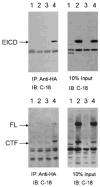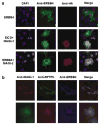Molecular dissection of NRG1-ERBB4 signaling implicates PTPRZ1 as a potential schizophrenia susceptibility gene
- PMID: 17579610
- PMCID: PMC5567789
- DOI: 10.1038/sj.mp.4001991
Molecular dissection of NRG1-ERBB4 signaling implicates PTPRZ1 as a potential schizophrenia susceptibility gene
Abstract
Neuregulin and the neuregulin receptor ERBB4 have been genetically and functionally implicated in schizophrenia. In this study, we used the yeast two-hybrid system to identify proteins that interact with ERBB4, to identify genes and pathways that might contribute to schizophrenia susceptibility. We identified the MAGI scaffolding proteins as ERBB4-binding proteins. After validating the interaction of MAGI proteins with ERBB4 in mammalian cells, we demonstrated that ERBB4 expression, alone or in combination with ERBB2 or ERBB3, led to the tyrosine phosphorylation of MAGI proteins, and that this could be further enhanced with receptor activation by neuregulin. As MAGI proteins were previously shown to interact with receptor phosphotyrosine phosphatase beta/zeta (RPTPbeta), we postulated that simultaneous binding of MAGI proteins to RPTPbeta and ERBB4 forms a phosphotyrosine kinase/phosphotyrosine phosphatase complex. Studies in cultured cells confirmed both a spatial and functional association between ERBB4, MAGI and RPTPbeta. Given the evidence for this functional association, we examined the genes coding for MAGI and RPTPbeta for genetic association with schizophrenia in a Caucasian United Kingdom case-control cohort (n= approximately 1400). PTPRZ1, which codes for RPTPbeta, showed significant, gene-wide and hypothesis-wide association with schizophrenia in our study (best individual single-nucleotide polymorphism allelic P=0.0003; gene-wide P=0.0064; hypothesis-wide P=0.026). The data provide evidence for a role of PTPRZ1, and for RPTPbeta signaling abnormalities, in the etiology of schizophrenia. Furthermore, the data indicate a role for RPTPbeta in the modulation of ERBB4 signaling that may in turn provide further support for an important role of neuregulin/ERBB4 signaling in the molecular basis of schizophrenia.
Figures





References
-
- Norton N, Williams HJ, Owen MJ. An update on the genetics of schizophrenia. Curr Opin Psychiatry. 2006;19:158–164. - PubMed
-
- Li D, Collier DA, He L. Meta-analysis shows strong positive association of the neuregulin 1 (NRG1) gene with schizophrenia. Hum Mol Genet. 2006;15:1995–2002. - PubMed
-
- Munafo MR, Thiselton DL, Clark TG, Flint J. Association of the NRG1 gene and schizophrenia: a meta-analysis. Mol Psychiatry. 2006;11:539–546. - PubMed
-
- Steinthorsdottir V, Stefansson H, Ghosh S, Birgisdottir B, Bjornsdottir S, Fasquel AC, et al. Multiple novel transcription initiation sites for NRG1. Gene. 2004;342:97–105. - PubMed
Publication types
MeSH terms
Substances
Grants and funding
LinkOut - more resources
Full Text Sources
Other Literature Sources
Medical
Research Materials
Miscellaneous

